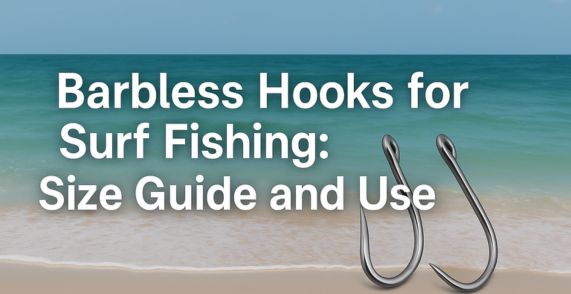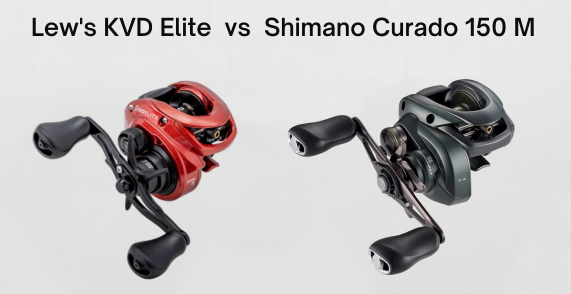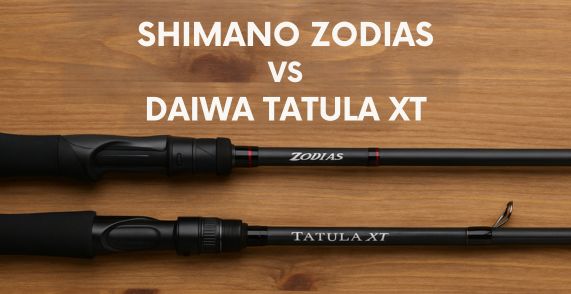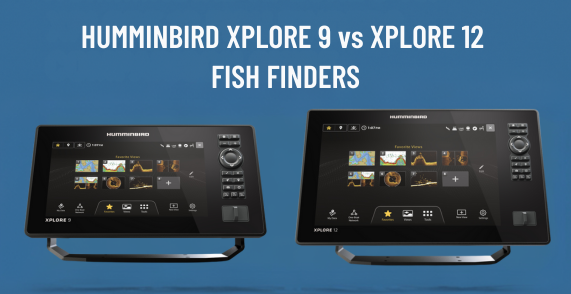In This Post
- 1 Key Takeaways
- 2 Why Barbless Hooks Are Revolutionizing Surf Fishing
- 3 Understanding Barbless Hooks for Surf Fishing
- 4 Comprehensive Size Guide for Surf Fishing Species
- 5 Mastering Barbless Hook Techniques in Surf Conditions
- 6 Creating and Modifying Your Own Barbless Hooks
- 7 Essential Catch-and-Release Practices with Barbless Hooks
- 8 Take Action: Make the Switch to Barbless Today
Key Takeaways
- Barbless hooks significantly improve fish survival rates during catch-and-release fishing by causing less damage and allowing for quicker release
- Match your barbless hook size to your target species: #4-1/0 for smaller fish like whiting and pompano, 1/0-5/0 for medium species like redfish, and 5/0-20/0 for larger species and sharks
- Maintaining constant tension on your line is crucial when using barbless hooks to prevent fish from shaking free
- Barbless hooks penetrate better than barbed hooks and are much safer for anglers if accidental hooking occurs
Why Barbless Hooks Are Revolutionizing Surf Fishing
Surf fishing continues to advance, with barbless hooks leading a shift toward more ethical angling practices.
After countless dawn hours casting into the surf, I’ve seen firsthand how these simple modifications profoundly improve the fishing experience.
Barbless hooks benefit fish and create better anglers who catch effectively while reducing harm. Standing at the ocean’s edge, feeling wave power and fish pull, knowing you’re minimizing damage adds depth to the experience.
Understanding Barbless Hooks for Surf Fishing
What Makes a Hook Barbless?
A barbless hook is exactly what it sounds like—a fishing hook without the small backward-facing projection (barb) that prevents fish from escaping once hooked.
Factory-made barbless hooks come without this feature, but you can easily create your own by crimping down the barb on any standard hook using flat-nosed pliers.
This simple modification transforms your tackle into a more fish-friendly tool without sacrificing effectiveness.
Environmental and Conservation Benefits
The conservation impact of barbless hooks cannot be overstated. They significantly reduce tissue damage when removing hooks from fish, which directly translates to higher survival rates for catch-and-release fishing.
With less trauma to the fish’s mouth, gills, or other tissues, fish return to their environment with a much better chance of survival. In areas with protected or threatened species, this small change can make a meaningful contribution to population recovery and sustainability.
Safety Advantages for Anglers
If you’ve ever experienced the searing pain of a hook embedded in your finger or hand, you’ll appreciate this benefit immediately.
Barbless hooks are far easier to remove from human skin, clothing, or equipment. What might be a trip-ending injury or emergency room visit with a barbed hook often becomes a minor inconvenience with a barbless one.
Simply back the hook out the way it went in, and you’re back to fishing within seconds.
Improved Hook Penetration
Contrary to what many anglers believe, barbless hooks actually penetrate better than their barbed counterparts. Without the resistance of the barb, the hook point drives in more easily, especially with harder-mouthed fish species.
This improved penetration often leads to more solid hooksets, which helps compensate for the lack of a barb to hold the fish. Many experienced anglers find they miss fewer strikes when using properly sharpened barbless hooks.
Comprehensive Size Guide for Surf Fishing Species
Small Species Hook Recommendations (#4-1/0 for Whiting, Pompano, Croaker)
When targeting smaller surf species like whiting, pompano, and croaker, selecting the right hook size is crucial.
These fish have relatively small mouths that require appropriately sized hooks for effective hooking without causing excessive damage. For these species, barbless hooks in sizes #4 to 1/0 provide the ideal balance.
Whiting and pompano respond particularly well to #1 to 1/0 circle hooks. The smaller gap matches their mouth size perfectly while still providing enough hook exposure for solid hooksets. For even smaller species like croaker and surf perch, consider downsizing to #4 or #2 hooks.
These smaller presentations allow for more delicate strikes and reduce the chance of gut-hooking, which is especially important when using barbless hooks.
Bait choice should complement your hook size. Sand fleas, small pieces of shrimp, and fish bites work exceptionally well on these smaller hooks.
The key is to ensure the bait doesn’t overwhelm the hook, allowing the point to remain exposed for easier penetration.
Medium Species Hook Sizing (1/0-5/0 for Redfish, Flounder, Striped Bass)
Medium-sized surf species demand a step up in hook size. For fish like redfish, flounder, and striped bass, barbless hooks in the 1/0 to 5/0 range prove most effective.
Redfish, with their powerful runs and hard mouths, typically require 2/0 to 5/0 hooks to ensure proper penetration and holding power throughout the fight.
Flounder and fluke, with their unique sideways mouths, respond well to 1/0 to 3/0 hooks. These hook sizes provide enough gap to accommodate their feeding style while ensuring the hook can be removed with minimal damage when using barbless versions.
Striped bass present an interesting challenge, as their size can vary dramatically.
For schoolie-sized stripers, #1 circle hooks can be sufficient, while trophy-sized specimens might require hooks up to 8/0.
Circle hooks are particularly beneficial for striped bass, as they naturally hook fish in the corner of the mouth, making barbless versions even more effective.
Large Species and Shark Hook Selection (5/0-20/0)
When your sights are set on the giants of the surf zone—sharks, tarpon, and other large predators—hook size becomes even more critical.
For these powerful fighters, barbless hooks in sizes 5/0 to 20/0 are necessary to match their mouth size and strength.
Shark fishing requires careful consideration of the target size. For smaller sharks (3-6 feet), hooks in the 5/0 to 10/0 range are appropriate.
Medium sharks (6-9 feet) call for 10/0 to 16/0 hooks, while trophy-sized sharks (9+ feet) demand hooks in the 16/0 to 20/0 range.
Tarpon, with their notoriously hard mouths, benefit from the improved penetration of barbless hooks. Sizes from 4/0 to 8/0 are typically recommended for these silver kings.
Remember that with these larger species, hook strength becomes just as important as size—choose hooks with appropriate wire gauges to prevent straightening during extended fights.
Mastering Barbless Hook Techniques in Surf Conditions
Proper Hook Setting Methods
The art of setting a barbless hook differs slightly from traditional barbed hooks. Without a barb to secure the hook in place, your technique must compensate.
For standard J-hooks that have been modified to barbless, a firm, steady pressure when setting is more effective than an aggressive jerk. This allows the hook point to seat properly without tearing a larger hole that might allow the hook to work free.
Circle hooks, which are excellent choices for barbless fishing, require a completely different approach. When using circle hooks, resist the urge to set the hook with a powerful upward swing.
Instead, when you feel a bite, simply start reeling while maintaining pressure. The hook’s design will naturally rotate and catch in the corner of the fish’s mouth as it tries to swim away.
In surf conditions, timing becomes even more critical. The constant motion of waves can create slack in your line, making hook sets more challenging.
Position yourself to maintain as direct a connection to your rig as possible, and be prepared to set the hook during moments of relative calm between wave surges.
Maintaining Tension Throughout the Fight
The golden rule of fishing with barbless hooks is maintaining constant tension on the line. Without a barb to prevent the hook from backing out, any slack can provide the fish an opportunity to shake free.
Keep your rod tip up at about a 45-degree angle to create a bend that acts as a shock absorber, cushioning sudden headshakes and runs while maintaining pressure.
Your drag setting becomes particularly important with barbless hooks. Set it tight enough to maintain pressure but loose enough to give line when the fish makes powerful runs.
This balance is crucial—too tight, and you risk breaking your line; too loose, and you might not maintain sufficient tension to keep the fish hooked.
Apply side pressure when appropriate by directing the rod to the left or right rather than straight up. This technique tires fish more quickly and helps maintain that critical tension throughout the fight.
It’s especially effective in surf conditions where waves and currents might otherwise create unwanted slack.
Landing Fish Successfully Without Barbs
The final moments of landing a fish on barbless hooks require extra attention.
As the fish nears shore or your landing net, maintain that same steady pressure—this is when many anglers lose fish by relaxing prematurely. If possible, back up the beach to slide the fish onto wet sand rather than trying to lift it through the air where gravity can help the hook fall out.
For catch-and-release fishing, consider leaving the fish in the water during unhooking. Barbless hooks allow for such quick removal that you can often unhook a fish without ever lifting it from the surf.
This minimizes stress and injury, increasing survival rates significantly.
If you must lift the fish, wet your hands first to protect its slime coat, and support its weight horizontally rather than hanging it vertically.
A rubberized, knotless landing net can be invaluable for safely controlling larger fish while keeping them partially submerged.
Creating and Modifying Your Own Barbless Hooks
Tools Needed for Barb Removal
Converting your existing hooks to barbless versions is a straightforward process that requires minimal tools. The most important tool is a good pair of flat-nosed pliers or small hand crimpers.
These allow you to precisely grip and flatten the barb without damaging the rest of the hook. For larger hooks, needle-nose pliers can provide better leverage, while smaller hooks might require more delicate jewelry pliers for precise work.
If you’re planning to completely remove the barb rather than just flatten it, you’ll need additional tools.
A small file or Dremel tool with a grinding attachment works well for smoothing any rough edges after crimping. This extra step ensures the hook slides out cleanly during fish release.
Keep a magnifying glass handy when working with smaller hooks to ensure you’ve completely flattened or removed the barb. This simple quality check can make a significant difference in hook performance and fish welfare.
Step-by-Step Crimping Process
Follow these steps to convert your barbed hooks to barbless:
- Secure the hook: Hold the hook firmly by the bend or eye using one hand or, preferably, a small vise to prevent movement during the crimping process.
- Position the pliers: Place the flat jaws of your pliers directly over the barb, ensuring they’re perpendicular to the hook shank for even pressure.
- Apply pressure: Squeeze firmly and steadily until the barb is completely flattened against the hook point. Don’t rush this step—gradual pressure prevents hook point damage.
- Inspect your work: Run your finger carefully along the hook from shank to point (in the opposite direction of how it would penetrate). You should feel no catching or resistance if properly crimped.
- Test the hook: Drag the point across a piece of cotton fabric. If it snags, the barb isn’t completely flattened and needs additional crimping.
For treble hooks, repeat this process for each point. Many conservation-minded anglers modify all hooks in their tackle box at once, using a rainy day to prepare for future fishing trips.
Essential Catch-and-Release Practices with Barbless Hooks
1. Minimizing Fish Handling Time
The golden rule of catch-and-release fishing is minimizing handling time, and barbless hooks make this significantly easier. Once you’ve landed a fish, keep it in the water if possible while removing the hook.
Barbless hooks typically slide out with minimal resistance, often requiring no tools at all.
If you must handle the fish, wet your hands thoroughly first. Dry hands remove the protective slime coat from fish, making them vulnerable to infection.
Never use a towel or gloves with rough surfaces, as these can cause similar damage.
Limit air exposure to less than 60 seconds—think of it as holding your breath while the fish is out of water.
If you need more time for a photo or to remove a difficult hook, briefly return the fish to water in between attempts to allow it to recover.
2. Proper Fish Revival Techniques
Even with barbless hooks and careful handling, some fish may appear stressed or exhausted after release. In these cases, proper revival techniques are essential.
Hold the fish gently in the water, facing it into the current so water flows naturally over its gills. This position supplies oxygen-rich water to the fish without requiring it to swim.
For surf fishing specifically, this might mean holding the fish in the wash zone where waves recede, allowing the natural back-and-forth motion of the water to flow over the gills.
Never move the fish back and forth in a sawing motion—this forces water backward through the gills and can cause additional stress or damage.
Watch for signs of recovery, such as stronger tail movements and attempts to swim away. Only release the fish when it shows these signs of revival. A properly revived fish will swim away strongly, not float or struggle at the surface.
3. When to Cut the Line vs. Remove the Hook
Despite your best efforts with barbless hooks, occasionally a fish might swallow the hook deeply or be hooked in a sensitive area like the gills.
In these situations, it’s often better to cut the line close to the hook rather than attempting to remove it.
Research has shown that fish survival rates are higher when deeply embedded hooks are left in place rather than removed through extensive manipulation.
This is especially true when using non-stainless steel hooks, which will naturally rust and deteriorate over time, often dislodging naturally or being encapsulated by the fish’s tissue without causing long-term harm.
The decision to cut the line should be made quickly to minimize stress.
If you can’t see the hook point or if removing it would require extensive probing or cause significant bleeding, cut the line as close to the hook as possible and release the fish promptly.
4. Species-Specific Handling Considerations
Different surf species require specialized handling techniques even when using barbless hooks:
- Sharks and Rays: Never lift these fish by their tails or gills. For small sharks, support their body weight horizontally while keeping them in the water. Cut the line close to the hook for larger specimens that cannot be safely handled.
- Flounder and Fluke: These flat fish have delicate mouths that tear easily. Use barbless hooks to minimize damage and remove them with a gentle twist rather than pulling.
- Redfish and Striped Bass: Support these larger fish horizontally under their belly and behind their pectoral fins. Never lift them vertically by their jaw or gills, as this can damage their internal organs.
- Pompano and Whiting: These smaller species can be briefly held with wet hands supporting their weight. Their scales dislodge easily, so minimize handling and avoid squeezing.
Take Action: Make the Switch to Barbless Today
The transition to barbless hooks represents more than just a change in tackle—it’s a commitment to more ethical, sustainable fishing practices.
By making this simple modification, you’re directly contributing to healthier fish populations and marine ecosystems while still enjoying the thrill of the catch.
Start small by converting a few hooks in your most-used rigs, then expand as you gain confidence in your barbless fishing techniques.
You’ll likely find that with proper technique, you land just as many fish while causing less harm. The minor adjustment to your fishing approach—maintaining tension and using proper landing techniques—quickly becomes second nature.
Remember that as surf anglers, we’re stewards of the shoreline environment. Our choices directly impact the health of coastal fisheries for generations to come.
Whether you’re a weekend warrior or a dedicated surf angler, the switch to barbless hooks is a meaningful step toward ensuring that the joy of surf fishing remains accessible for years to come.







